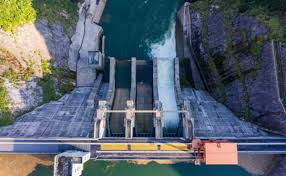China approves construction of World’s Largest Hydropower Dam on the Brahmaputra River

- 28 Dec 2024
In News:
China approved the construction of the world's largest dam, stated to be the planet's biggest infra project, on the Brahmaputra river in Tibet close to the Indian border, raising concerns in India and Bangladesh.
Key highlights:
Overview of the Project:
- Location: Lower reaches of the Yarlung Zangbo River (Tibetan name for Brahmaputra), where the river makes a U-turn in the Himalayan region before flowing into Arunachal Pradesh, India.
- Purpose:
- To support China’s carbon neutrality goals.
- To boost industrial growth and create jobs in Tibet.
- Expected to generate 300 billion kWh of electricity annually, over three times the capacity of the Three Gorges Dam in central China.
Significance:
- Scale: The dam is poised to be the world’s largest hydropower project, surpassing the Three Gorges Dam, and becoming the biggest infrastructure project globally, with an estimated cost of USD 137 billion.
- Engineering Challenges: The site is located in a seismic zone on the Tibetan plateau, prone to earthquakes, making construction and operational stability a major engineering challenge.
Concerns:
- Environmental Impact:
- Potential disruption to the local ecosystem and biodiversity.
- Risk of altering the river’s flow and course, which could impact agriculture and water resources downstream, particularly in India and Bangladesh.
- Geopolitical Risks:
- Water control: India and Bangladesh are concerned about China’s ability to control the water flow, with fears of China manipulating the flow to release excess water during conflicts, causing potential flooding in border areas.
- The project could also disrupt the hydrological cycle, affecting the region’s water availability, especially in Assam and Bangladesh.
Background:
- The Brahmaputra River is a trans-boundary river, flowing through China, India, and Bangladesh. Known by different names in these countries, it plays a vital role in the livelihoods of millions of people.
- China has already initiated hydropower generation on the upper reaches of the Yarlung Zangbo, with plans for additional projects upstream.
India-China Cooperation:
- China and India have an Expert Level Mechanism (ELM) in place since 2006 to manage trans-boundary river issues, under which China shares hydrological data with India, especially during the flood season.
- India is also constructing its own hydropower projects on the Brahmaputra in Arunachal Pradesh.
Potential Outcomes:
- Energy Generation: The dam could significantly contribute to China’s energy needs, providing a substantial amount of renewable energy.
- Regional Tensions: The dam’s construction may escalate tensions between China, India, and Bangladesh due to the control over water resources and environmental impact concerns.
